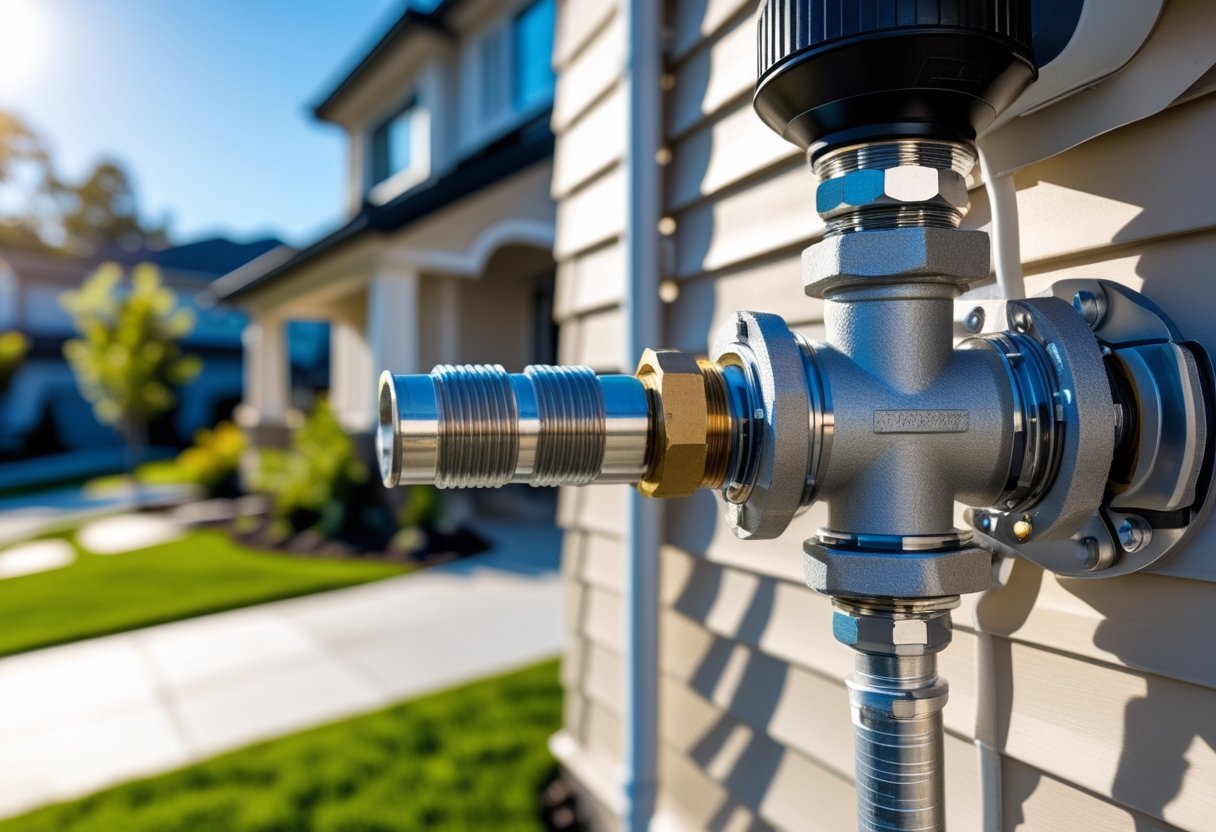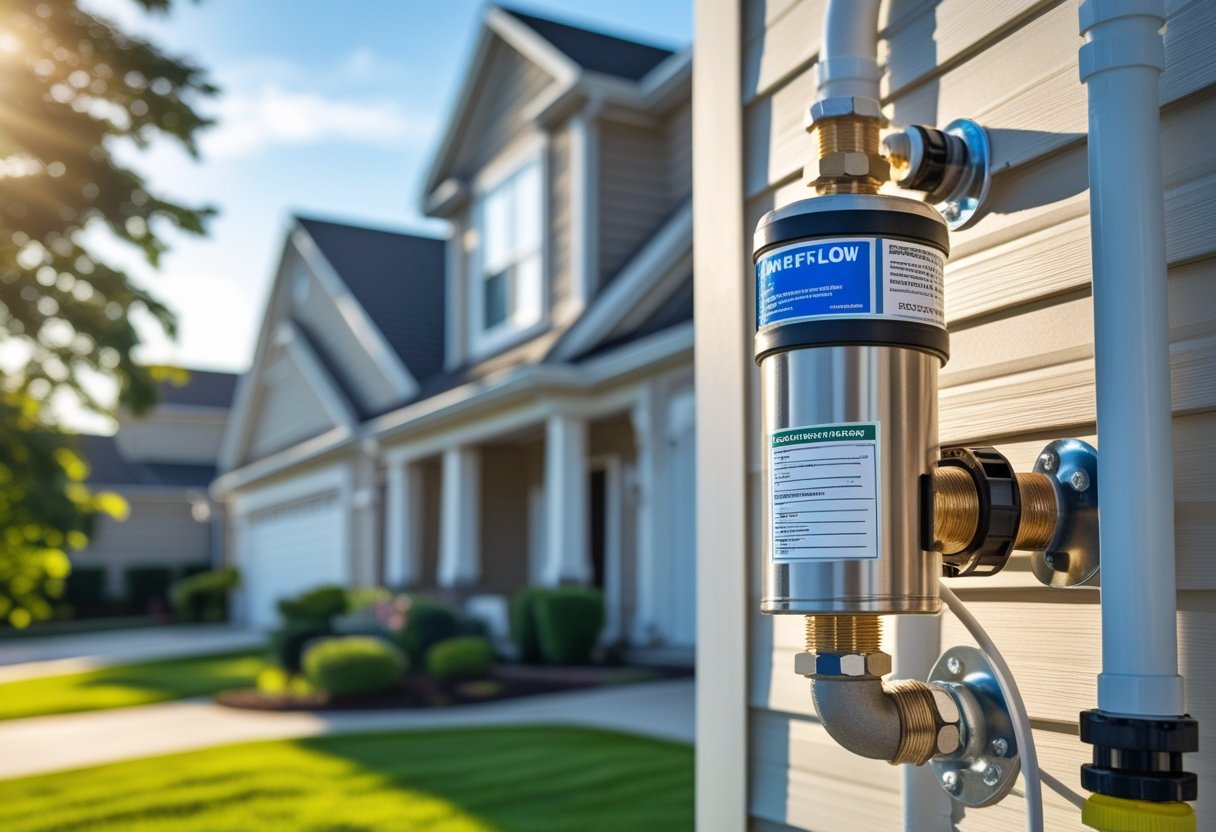If you have a backflow prevention device, you might wonder how often it needs testing. Backflow devices should be tested at least once a year to make sure they work and keep your water supply safe from contamination. Regular testing matters because a bad device can let dirty water sneak backward into your clean water system—nobody wants that.
Annual testing isn’t just good practice—it’s usually required by local rules, especially in places like San Diego County. Keeping up with testing helps you avoid fines and keeps your property in compliance with water authority regulations. At Pacific Backflow, we offer reliable, fast, and low-hassle testing to keep your system working as it should.
Testing your backflow device is a straightforward way to protect your home or business. If something’s wrong, Pacific Backflow can handle repairs or new installations to get you up to code quickly. Keeping your water safe really is easier when experts are just a call away.
What Are Backflow Devices?
Backflow devices are essential for keeping your water supply clean and safe. They stop contaminated water from flowing backward into your home or business water lines. There are different types, each designed for specific locations and risks.
Purpose of Backflow Devices
Backflow devices protect your clean water from pollution. They keep contaminated water—like from irrigation, chemicals, or waste—from mixing with your drinking water. Without them, harmful substances could get into your pipes and cause health problems.
They also help you meet local safety rules and keep your water system working smoothly. By stopping backflow, they help protect your family, employees, and neighbors from unsafe water.
Types of Backflow Preventers
You’ll find a few main types of backflow preventers:
- Atmospheric Vacuum Breakers (AVBs): Simple devices that prevent water from being sucked back if pressure drops.
- Pressure Vacuum Breakers (PVBs): Designed for systems under pressure, often used for irrigation.
- Double Check Valve Assemblies (DCVs): These use two valves for extra protection—common in homes.
- Reduced Pressure Zone Devices (RPZs): Offer top-level protection where contamination risks are highest.
Each type has its own purpose and typical installation spot. Knowing which one you have (or need) helps you stay out of trouble with local laws. If you need quick testing or repairs, Pacific Backflow covers all of San Diego County and can help keep your device in shape.
Why Backflow Device Testing Matters
Testing your backflow device keeps your water supply safe, helps avoid plumbing headaches, and keeps you on the right side of local laws. Skipping tests? That can mean health risks, bad water, and legal hassles. Regular checks really do protect you and your neighbors.
Risks of Untested Backflow Devices
If you don’t test your backflow device, it might fail and you’d have no idea. A broken preventer could let dirty water slip back into your clean water system. That messes up your plumbing and could expose you to bacteria or chemicals.
Parts like rubber seals or valves wear out over time. Annual testing catches issues early. Fixing things right away stops leaks and helps avoid expensive repairs down the line.
Impact on Water Quality
Your backflow device keeps dirty water out of your drinking supply. If it fails, stuff like pesticides, fertilizers, or bacteria can get in. Suddenly, your water isn’t safe to drink or use.
Regular testing checks that your device works and that valves open and close at the right pressure. Clean water is non-negotiable for health, cooking, and bathing, so keeping your backflow device working is pretty much a must.
Legal and Public Health Considerations
Most local governments—including San Diego County—require annual backflow testing by licensed technicians. Not getting it done can mean fines or even losing water service.
Certified testers send your results to the water authorities, so you stay in compliance. This also helps keep everyone’s water safe.
When you work with a company like Pacific Backflow, you get simple testing and peace of mind that your system’s safe and legal.
Recommended Testing Frequency for Backflow Devices
Backflow devices need regular testing to keep your water safe and stay on the right side of the rules. Testing finds problems before they get serious. Most places call for annual testing, but local guidelines might tweak that.
General Testing Guidelines
Backflow devices usually get tested once a year. Certified professionals look for leaks, blockages, or worn-out parts.
Spring or early summer is a popular time for maintenance. Annual checks catch issues before they become expensive headaches. If your device fails, it should get fixed or replaced quickly to avoid contamination.
Keep detailed records of each test—makes life easier if you ever need to show proof.
Municipal and State Requirements
Local water authorities almost always require annual testing. For example, San Diego wants yearly tests and official reports filed with the water department. Some places also want immediate testing after a new device install or after repairs.
Starting July 2025, testers in many areas need approved qualifications. This is to make sure tests are accurate. While most counties want pros to do the work, a few let homeowners handle it if they follow strict steps.
To stay compliant in San Diego County, it’s just easier to use a company like Pacific Backflow. They handle testing, reporting, repairs, and replacements—less paperwork and fewer headaches for you.
Factors Influencing Testing Intervals
How often your backflow preventer needs a check depends on a few things. Location and environment matter. So do the age and condition of your device.
Environmental and Location Factors
Where you live makes a difference. If your area has old pipes or lots of construction, you might need more frequent checks.
Places with a history of water contamination or frequent droughts? Testing intervals could be shorter. This helps keep unsafe water out of your clean supply.
Local rules can also change the schedule. Some cities stick to annual testing, but if risks are higher, they might require it twice a year or after big repairs.
Device Age and Condition
Older backflow preventers wear out faster—rubber seals and discs don’t last forever. If your device is over five years old, you might want to test it more often.
If your preventer has failed a test before, your water provider or technician could suggest extra inspections. Damage or leaks? Get it checked right away.
Regular testing helps you dodge bigger repairs or replacements. Services like Pacific Backflow have certified technicians who can spot issues before they turn into big problems.
Who Should Test Backflow Preventers?
Testing backflow preventers keeps your water safe and helps you follow the rules. It’s not really a DIY job—you need someone with the right skills and certifications. You’re also responsible for keeping records and making sure testing happens on time.
Certified Inspectors and Technicians
Only certified inspectors or technicians should test your backflow preventer. These folks know how to spot problems and do the right tests. They use special tools to check if your device actually blocks dirty water.
Hiring a certified tester means your device gets checked the right way. Most places require testers to be licensed, so don’t just let anyone do it.
Companies like Pacific Backflow have certified, experienced pros. They handle the test and send reports to your water provider—so you stay in compliance without the hassle.
Property Owner Responsibilities
You’re responsible for making sure your backflow preventer gets tested as your water authority requires. Usually, that means once a year.
Keep clear records of all tests, repairs, and inspections. If the water district asks, you need to show you followed the rules.
It’s on you to schedule testing on time. If your device fails, get repairs or a replacement fast to avoid water contamination.
Stay on top of it and you protect your home and your neighbors’ water. Plus, your plumbing will thank you.
Consequences of Missing Regular Tests
Skip regular backflow device testing and you open yourself up to fines and health risks. These problems can hit your property—and your whole community.
Financial and Legal Penalties
Miss a deadline and local water agencies will probably fine you. Ignore it, and the fines just get bigger.
In some cases, your water might get shut off until you complete the required test and fix any issues. That’s a headache nobody wants.
You also need to keep test records for at least three years. If you can’t prove you did the test, you could face extra penalties. Companies like Pacific Backflow take care of testing and reporting, so you don’t have to stress.
Risks to Community Health
Your backflow device keeps dirty water out of the clean system. Without regular testing, a broken device might let harmful chemicals or bacteria get into drinking water.
This contamination risk isn’t just your problem—it can affect your neighbors and the public water supply. Keeping the community safe depends on working devices.
Annual testing catches issues early, so you can fix or replace the device before anything bad happens. It’s a simple step with a big impact.
How to Schedule and Prepare for Backflow Testing
Scheduling your backflow test early and knowing what to expect can save you hassle. Book with a certified tester and make sure they have easy access to your device.
Booking a Certified Tester
Start by picking a certified tester licensed by your local water authority. Cities like San Diego County require annual testing by certified pros.
Reach out by phone, email, or online forms. When you book, have your backflow preventer’s location and any recent test reports handy—makes things go faster.
Mention if your property is residential or commercial, since that affects what the tester needs to know. Ask if they’ll file your test reports with the city so your records stay current.
Pacific Backflow, for example, handles everything from booking to filing reports, so you can cross this off your list with minimal fuss.
What to Expect During an Inspection
When you schedule an inspection, a technician will hook up a testing device to your backflow preventer. They want to see if your system actually stops water from reversing into your clean water supply—pretty important stuff.
They’ll check for leaks, rust, and any obvious damage. If everything looks good, the technician files a report with the local water authority—sometimes that happens right away, sometimes it takes a day or two.
If there’s an issue, the tester will let you know what needs fixing. Sometimes you’ll hear that the device is shot and needs replacing. A decent provider should walk you through your options, not just hand you a bill.
Before the inspection, clear the area around your backflow preventer. Seriously, it saves everyone time and keeps things moving.
Maintaining Compliance and Record Keeping
Staying on top of your backflow testing schedule also means keeping your paperwork in order. You want to make sure you’re following local rules and can prove your system’s up to snuff if anyone asks.
Documenting Test Results
After every test, jot down the date, the results, any repairs, and who did the work. Over time, these records help you spot if something keeps going wrong with your device.
Hang onto your test reports—physical copies, digital files, whatever works for you. Some water authorities want you to keep them for years, so don’t toss anything too soon.
If you use a pro like Pacific Backflow, they’ll hand over clear, official test reports right after the job. You’ll get your own copies for your records, too.
Submitting Reports to Authorities
Most local water agencies want your backflow test reports after each inspection. That’s how you show you’re following the rules and protecting the water supply.
Deadlines usually come up fast after the test, so don’t drag your feet. Missing or late reports can mean fines or, worse, water shutoffs.
You might need to mail, email, or upload your documents, depending on what your area wants. If you go with a company like Pacific Backflow, they’ll handle the filing for you—one less thing to worry about.
Always double-check that your report made it through. Save any confirmation or receipt from the agency. If someone ever questions you, you’ll have proof you did your part.
Frequently Asked Questions
Backflow preventers need regular checks to keep your water safe and to stay on the right side of local rules. How often you test them depends on your property and the device. And yeah, there are laws, and missing a test can mean fines.
What is the recommended frequency for testing backflow preventers?
Aim for once a year. Annual testing makes sure your device works and keeps your water supply safe.
Can you tell me how often commercial backflow devices need to be checked?
Most commercial backflow devices need annual testing. Some places might have extra rules, but yearly is pretty standard.
What are the routine testing intervals for residential backflow prevention devices?
For homes, once a year is the usual advice. Regular checks help you catch problems before they turn into expensive repairs.
Is there a legal requirement for how regularly backflow systems must be inspected?
Yes, most areas have laws that require yearly testing. Skip it and you could face fines or lose water service.
How does the testing frequency for backflow devices change with different types of systems?
Nearly all backflow devices—irrigation, residential, commercial—need annual testing. Sometimes older systems or certain locations might need even more frequent checks, but yearly is the baseline in most places.
Are there any penalties for not adhering to the testing schedule for backflow preventers?
Yep, there are. If you miss the required tests, you might get fined or even have your water service interrupted. So, sticking to the schedule isn’t just about rules—it’s about keeping your water safe and avoiding a headache later.
Looking for reliable backflow testing in San Diego County? Pacific Backflow’s certified team can take care of the testing and reporting, making the whole process a lot less stressful.











